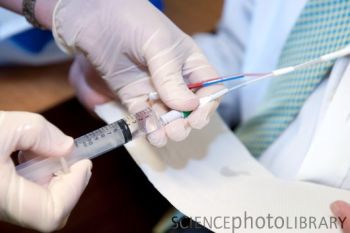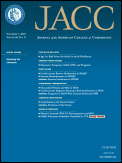导读:加利福尼亚大学圣地亚哥分校的研究人员开发出一种新型的可注射水凝胶,能够安全有效地修复由心脏病发作引起的组织损伤。更重要的是,这种凝胶可以通过导管注射,而无需进行外科手术或者全身麻醉。

加利福尼亚大学圣地亚哥分校的研究人员开发出一种新型的可注射水凝胶,能够安全有效地修复由心脏病发作引起的组织损伤。
这项研究发表在2月21出版的Journal of the American College of Cardiology期刊上,由Karen Christman和她的同事共同完成。Christman是加州大学圣地亚哥分校雅各布工程学院的生物工程系教授,她和别人合伙创办了Ventrix公司,并计划在明年将该凝胶投入临床试验。
Christman解释道:“在美国,每年大约有785,000起心脏病袭击事件,且目前并没有既定的用于修复受损心肌组织的治疗方案,因此,凝胶疗法极有可能能够受到人们的追捧。”
这种凝胶来自从心肌细胞剥离出的心脏结缔组织。心脏结缔组织经清洗、冻干、研磨成粉和液化变成一种能够被轻易注入心脏的液体。一接触到体温,这种液体就会变成一种半固体状的多孔凝胶,促使细胞重新“入驻”受损心肌组织,并能维持心脏功能,Christman说。这种凝胶为修复受损组织提供了支架,并为防止周围组织的进一步恶化提供了可能的生化信号。
“它有助于心脏形成一个新的积极回应模式,而不是在已有的伤口上‘撒盐’。”
更重要的是,研究人员的实验结果表明,这种凝胶也可以通过导管注射,这样就能够使患者创伤最小化,且无需进行外科手术或者全身麻醉。
由Christman和她的科研团队所执行的一项新的、尚未发表的研究显示:这种凝胶能够提高遭受心肌损伤的猪的心脏功能,使得这种潜在疗法向人类又迈进了一步。
很少有可注射的心脏病疗法可应用于像猪这样的大型动物的,它们的心脏大小、功能和人类相当,Christman解释道。“此前,人们所关注的大部分材料都只停留在在老鼠身上试验,可通过针头和注射器注射,但是,这些材料几乎没有能通过导管注射的,而且凝固太快,容易在注射的过程中就阻塞导管。”
Christman的科研团队在用老鼠做实验时发现,机体并不排斥这种凝胶并且也不会引发心律失常,这在一定程度上为“凝胶对人类同样安全”提供了一些保证。
Christman持有Ventrix公司的股份并同时兼任该公司的科学顾问,所以该公司很有可能成为此项研究成果的获益者。

Catheter-Deliverable Hydrogel Derived From Decellularized Ventricular Extracellular Matrix Increases Endogenous Cardiomyocytes and Preserves Cardiac Function Post-Myocardial Infarction
Jennifer M. Singelyn, PhD, Priya Sundaramurthy, MS, Todd D. Johnson, BS, Pamela J. Schup-Magoffin, BA, Diane P. Hu, MS, Denver M. Faulk, BS, Jean Wang, BS, Kristine M. Mayle, BS, Kendra Bartels, RN{dagger}, Michael Salvatore, BS, Adam M. Kinsey, PhD, Anthony N. DeMaria, MD, Nabil Dib, MD, MSc and Karen L. Christman, PhD
Objectives: This study evaluated the use of an injectable hydrogel derived from ventricular extracellular matrix (ECM) for treating myocardial infarction (MI) and its ability to be delivered percutaneously.
Background: Injectable materials offer promising alternatives to treat MI. Although most of the examined materials have shown preserved or improved cardiac function in small animal models, none have been specifically designed for the heart, and few have translated to catheter delivery in large animal models.
Methods: We have developed a myocardial-specific hydrogel, derived from decellularized ventricular ECM, which self-assembles when injected in vivo. Female Sprague-Dawley rats underwent ischemia reperfusion followed by injection of the hydrogel or saline 2 weeks later. The implantation response was assessed via histology and immunohistochemistry, and the potential for arrhythmogenesis was examined using programmed electrical stimulation 1 week post-injection. Cardiac function was analyzed with magnetic resonance imaging 1 week pre-injection and 4 weeks post-MI. In a porcine model, we delivered the hydrogel using the NOGA-guided MyoStar catheter (Biologics Delivery Systems, Irwindale, California), and utilized histology to assess retention of the material.
Results: We demonstrate that injection of the material in the rat MI model increases endogenous cardiomyocytes in the infarct area and maintains cardiac function without inducing arrhythmias. Furthermore, we demonstrate feasibility of transendocardial catheter injection in a porcine model.
Conclusions: To our knowledge, this is the first in situ gelling material to be delivered via transendocardial injection in a large animal model, a critical step towards the translation of injectable materials for treating MI in humans. Our results warrant further study of this material in a large animal model of MI and suggest this may be a promising new therapy for treating MI.
文献链接:








